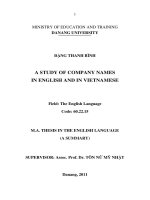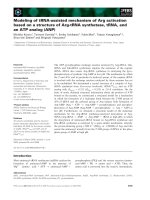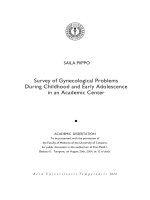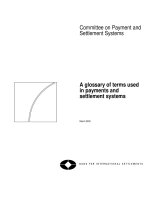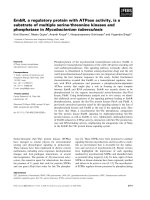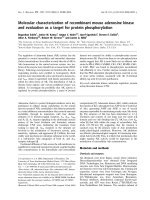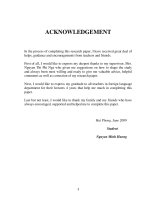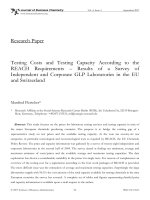a survey of recommender systems techniques, challenges and evaluation metrics
Bạn đang xem bản rút gọn của tài liệu. Xem và tải ngay bản đầy đủ của tài liệu tại đây (343.01 KB, 5 trang )
International Journal of Emerging Technology and Advanced Engineering
Website: www.ijetae.com (ISSN 2250-2459, Volume 2, Issue 11, November 2012)
382
A Survey of Recommender Systems Techniques, Challenges
and Evaluation Metrics
Tranos Zuva
1
, Sunday O. Ojo
2
, Seleman M. Ngwira
1
and Keneilwe Zuva
3
1
Department of Computer Systems Engineering, Soshanguve South Campus, South Africa
2
Faculty of Information and Communication Technology, Soshanguve South Campus, South Africa
3
Department of Computer Science, University of Botswana, Gaborone, Botswana
Abstract - Recommender systems are software
applications that belong to a class of personalized
information filtering technologies that aim to support
decision making in large information space. There are
various techniques being used to achieve this goal in
traditional and mobile recommender systems. The
recommender systems techniques are usually classified in
four main categories: Collaborative Filtering (CF), Content
Based Filtering (CBF), Knowledge Based Filtering (KBF)
and Hybrid Filtering (HF). In this paper an overview of
these techniques, challenges and evaluation metrics of
recommender systems is discussed.
Keywords — Recommender System, Decision Support,
Information Filtering, Evaluation Metrics
I. INTRODUCTION
Recommender systems belong to a class of
personalized information filtering technologies that aim
to meaningfully suggest which items or products
available might be of interest to a particular user [1-2].
These systems make recommendations using three
fundamental steps: preferences acquisition (acquiring
preferences from the user’sinputdata),recommendation
computation (computing recommendations using proper
methods) and recommendation presentation (presenting
the recommendation to the user) [3]. Based on various
techniques used in recommendation computation existing
recommendation systems can be classified into four
fundamental categories shown in Figure 1, that is,
Collaborative Filtering (CF), Content-Based Filtering
(CBF), Knowledge-Based filtering (KBF) and Hybrid
Filtering (HF). Surveys and reviews give researchers an
overview of developments, achievements, challenges,
direction and open issues within a given area.
This paper is organized as follows: Collaborative
Approach, Content Based Approach, Knowledge- Based
Approach, Hybrid Approach, Challenges, Performance
Evaluation and Summary.
Figure 1: Classification of Recommender Systems
II. COLLABORATIVE FILTERING (CF)
CF systems obtain user feedback in the form of ratings
in a given application domain then exploit similarities
and differences among profiles of several users to
generate recommendations [4]. Algorithms for CF
recommender systems can be grouped into two general
classes: memory based (algorithms that require all
ratings, items and users be stored in memory) and model
based (algorithms that periodically create a summary of
ratings patterns offline) [5-6]. Most commonly used are
the model based algorithms due to the fact that run-time
complexities are reduced.
Recommender
Systems
(RS)
Collaborativ
e
Filtering
(CF)
Content-
Based
Filtering
(CBF)
Knowledge-
Based
Filtering
(KBF)
Hybrid
Filterin
g (HF)
International Journal of Emerging Technology and Advanced Engineering
Website: www.ijetae.com (ISSN 2250-2459, Volume 2, Issue 11, November 2012)
383
CF techniques can also be grouped into non-
probabilistic and probabilistic algorithms. Probabilistic
CF algorithms are those that are based on an underlying
probabilistic model. Non-probabilistic CF algorithms are
not based on probabilistic model. The non-probabilistic
CF algorithms are the most commonly used [5-7].
Nearest neighbour algorithms are well-known CF non-
probabilistic algorithms. There are two different classes
of nearest neighbour CF algorithms that are User-based
nearest neighbour and Item-based nearest neighbour. CF
algorithms use a ratings matrix,
R
, to represent the
complete
nm
user-item data,
m
represents the
th
m
user and
th
n
item. Each entry
iu
R
,
is the score of item
i
rated by user
u
within a certain numerical scale. The
matrix is illustrated in table 1 below.
Table 1
User Rating Data Matrix
R
1
Item
2
Item
Item
i
Item
Item
n
Item
1
User
1,1
R
2,1
R
, 1
R
i
R
,1
, 1
R
n
R
,1
2
User
1,2
R
2,2
R
, 2
R
i
R
,2
, 2
R
n
R
,2
User
1 ,
R
2 ,
R
,
R
i
R
,
,
R
n
R
,
u
User
1,u
R
2,u
R
, u
R
iu
R
,
, u
R
nu
R
,
User
1 ,
R
2 ,
R
,
R
i
R
,
,
R
n
R
,
m
User
1,m
R
2,m
R
, m
R
im
R
,
, m
R
nm
R
,
This section will discuss the user-based nearest
neighbour and item-based nearest neighbour algorithms
then the practical challenges of CF algorithms in general.
A User-based Nearest Neighbour
In the user-based neighbour collaborative filtering
recommendation systems, the prediction of likeness of an
item for an active user
u
is based on ratings from similar
users.
These users are called neighbours of
u
. User-based
algorithms generate a prediction for an item
i
by
analyzing ratings for
i
from users in the
u
’s
neighbourhood. Suppose we have a user-item rating
matrix
nm
R
*
, which means
m
is the number of all users
n
is the number of all items and
iu
R
,
is the score of item
i
rated by user
u
, showing the user’s degree of
preference for item as in table 1. The most significant
step in user-base neighbour CF algorithm is to search the
neighbour of the target user
t
u
. To be able to find the
neighbour of the target user
t
u
, similarity algorithm is
used.
There are two most used to compute similarity
methods: cosine similarity and Pearson correlation
coefficient similarity. The formula for Pearson is given in
equations (1).
t
uu
t
uu
tt
t
uu
t
t
Ii Ii
uiuuiu
Ii
u
iuuiu
t
RRRR
RRRR
uuUsersim
, ,
,
2
,
2
,
,,
),(
(1)
Where
),(
t
uuUsersim
represent the similarity
between user
t
uandu
,
)()(
tuu
uIuII
t
means the
item set rated simultaneously by user
t
uandu
,
iuiu
t
RandR
,,
are the scores of item
i
rated by users
t
uandu
respectively,
t
uu
RandR
represent the
average scores of users
t
uandu
respectively.
The last step is when
t
u
N
denotes the target user
t
u
’s
neighbour set. We would want to predict
t
u
rating for
item
j
. The following equation (2) will be used.
t
un
nn
t
Nu
nt
ntuju
u
t
baseduser
uusim
uusimRR
AjuP
|)(|
),(*
),(
,
(2)
International Journal of Emerging Technology and Advanced Engineering
Website: www.ijetae.com (ISSN 2250-2459, Volume 2, Issue 11, November 2012)
384
Where
t
u
A
represents the average score for user
t
u
for
the rated items,
ju
n
R
,
is the score of item
j
rated by
neighbour user
n
u
,
n
u
R
means the average score of
neighbour
n
u
for the rated items,
),(
nt
uusim
means the
similarity between user
t
u
and the neighbour
n
u
.
This will be used to recommend an item to target user.
For cosine based similarity algorithm refer to (Bigdeli,
2008).
B Item-based Nearest Neighbour
Item-based nearest neighbour algorithms are transpose
of the user-based nearest neighbour algorithms. Item-
based algorithms create predictions based on similarities
between items [5].
There are many ways to calculate the similarity
between items. Some of the most popular algorithms are
cosine based similarity, correlation based similarity and
adjusted-cosine similarity. The formula for Adjusted-
based cosine which is the most popular and believed to
be the most accurate [5, 8] is given in equation (3).
jiji
ji
Uu
uju
Uu
uiu
Uu
u
ju
u
iu
RRRR
RRRR
jiItemsim
,,
,
2
,
2
,
,,
))(
))((
),(
(3)
Where
juiu
RandR
,,
represents the rating of user
u
on items
jandi
respectively,
u
R
is the mean of the
th
u
user’sratingsand
ji
U
,
represents all users who have
rated items
jandi
.
The prediction calculation for item based nearest
neighbour algorithm for user
u
and item
j
is carried out
using formula (4) below.
t
u
t
u
t
Ri
Ri
ju
t
baseditem
jiItemsim
RjiItemsim
juP
),(
*),(
),(
,
(4)
If the predicted rating is high then the system
recommends the item to user. The item-based nearest
neighbour algorithms are more accurate in predicting
ratings than user based nearest neighbour algorithms [5].
III. CONTENT-BASED FILTERING
CBF approaches recommend items that are similar in
content to the items the user liked in the past or march to
the attributes of the user [9-10]. In content based filtering
recommender systems every item is represented by a
feature vector or an attribute profile. The feature hold
numeric or nominal values representing certain aspects of
the item like colour, price, etc. A variety of (dis)
similarity measures between the feature vectors may be
used to compute the similarity of two items. The
Euclidean or cosine (dis)similarity algorithms can be
used and they are given in equations (5) and (6)
respectively.
Euclidean dissimilarity
2
1
2
||||)(),( yxyxyxdissim
n
i
ii
(5)
Cosine similarity
n
i
i
n
i
i
n
i
ii
yx
yx
yxsim
1
2
1
2
1
*
),(
(6)
Where
yandx
are an items vectors with
n
elements
in them,
),(),( yxsimandyxdissim
measure the
distance apart and closeness respectively.
The (dis)similarity values are then used to obtain a
ranked list of recommended items. These approaches are
based on information retrieval because content associated
with the user’s preferences is treated as a query and
unrated objects are scored with similarity to the query.
This approach can give recommendations in any domain.
Content based recommender systems work well if the
items can be properly represented as a set of features.
IV. KNOWLEDGE BASED RECOMMENDER SYSTEMS
Knowledge based systems use knowledge structure to
make inference about the user needs and preferences
[11]. Knowledge based approaches are well-known in
that they have functional knowledge: they have
knowledge about how a particular item satisfies a
particular user need, and can therefore reason about the
relationship between a need and possible
recommendation [12]. The user profile can be any
knowledge structure that supports this inference.
International Journal of Emerging Technology and Advanced Engineering
Website: www.ijetae.com (ISSN 2250-2459, Volume 2, Issue 11, November 2012)
385
V. HYBRID RECOMMENDER SYSTEMS
A hybrid is combination of at least two techniques in
order to overcome the deficiencies of a single method
used in isolation [10]. One way is to combine content
based and collaborative filtering algorithms in such a
way that they produce separate ranked lists of
recommendations then merge them to make up the final
recommendations [9]. Some notable examples of hybrid
recommender systems are Weighted and Switching
hybrid recommender systems. A weighted hybrid
recommender is one in which the score of a
recommended item is calculated from the results of all of
the available recommendation algorithms in the system.
For example the simplest combined hybrid recommender
systems would be a linear combination of
recommendation scores. Switching Hybrid recommender
system (SH) uses some criterion to switch between
recommendation techniques. Example of (SH)
recommender system is the DailyLearner that uses a
content\collaborative hybrid. In this hybrid content based
recommendation algorithm is employed first then
collaborative if the first results are not satisfactory [13-
14].
VI. CHALLENGES OF RECOMMENDATION TECHNIQUES
Recommender systems techniques have been very
successful in past, but their extensive use has exposed
some real challenges. Some of the challenges are: Data
Sparsity, Cold Start Problem, Fraud, Scalability, Gray
sheep, Shilling attack and synonymy [6-7, 9, 15].
Data Sparsity: In practice, many commercial
recommender systems are used to evaluate very large
item sets (e.g. Amazon.com, CDnow.com). In these
systems, even active users may have purchased one
percent of the items (1% of two million of books is 20
000 books). The user-item matrix used for CF will be
extremely sparse and a recommender system based on
nearest neighbour algorithms may be unable to make any
item recommendations for a particular user. The system
becomes very ineffective. Under data sparsity there is
also reduced coverage and neighbour transitivity [5, 7].
Coverage can be defined as the percentage of items that
the system could provide recommendations for. The
reduced coverage problem arises when the number of
users’ratingsmaybeverysmallcomparedwiththelarge
number of items in the system and the recommender
system may fail to generate the recommendations for
them. Neighbour transitivity refers to a problem with
sparse databases, in which users with similar tastes may
not be identified if they have not rated the same items.
Content based approaches can also solve the problem
since they do not require ratings from other users.
Cold start problem describes a situation in which a
recommender system is unable to make meaningful
recommendations due to an initial lack of ratings. Cold
start occurs when a new user or item has just entered the
system, it is very difficult to find similar ones due to
inadequate enough information. New items cannot be
recommended until some users rate them. The new item
problem affects collaborative filtering recommender
systems. Since content based filtering recommender
systems do not dependent on ratings from other users,
they can be used to produce recommendations for all
items provided attributes of the items are available. New
users are very unlikely to be given good
recommendations because of lack of their rating or
purchase history. Research to solve the new user problem
is focusing on effectively selecting items to be rated by
the user to quickly get the user preferences to improve
the recommendation performance [9].
Scalability: When the population of existing users and
items grow tremendously, the traditional recommender
systems algorithms will suffer serious scalability
problems, with computational resources going beyond
practical or acceptable levels.
Synonymy: When a number of the same or very similar
items have a different name and recommender systems
fail to discover this latent association then treat these
products differently.
Gray Sheep and Black Sheep: When a user whose
opinions do not consistently correlate in agreement or
disagreement with any group of people and thus not
benefit from the system. The gray sheep users problem is
also responsible for increased error rate in collaborative
filtering recommender systems [16], which often result in
failure of recommender systems. Black sheep are those
users who have no or very few people who they correlate
with. This situation makes it very difficult to make
recommendation for them [12].
Fraud: Recommender systems are increasingly being
adopted by commercial websites due to their economic
benefits to the retailers and service providers.
Unprincipled competing vendors have started to engage
in different forms of fraud in order to cheat the
recommender systems to their advantage. They have
endeavoured to inflate the perceived attractiveness of
their own commodities (push attacks) or reduce the
ratings of their rivals (nuke attacks). These attacks are
also known as shilling attacks [7, 9].
With all these challenges encountered in the use of
recommendation systems, there is need to evaluate the
performance of the developed systems. The evaluation of
the systems enables to determine the accuracy of the
systems.
International Journal of Emerging Technology and Advanced Engineering
Website: www.ijetae.com (ISSN 2250-2459, Volume 2, Issue 11, November 2012)
386
VII. EVALUATION METRICS FOR RECOMMENDER
SYSTEMS
The performance of recommender system can be
evaluated by comparing recommendations to a test set of
known user ratings. These systems are commonly
measured using predictive accuracy metrics, where the
predicted ratings are directly compared to actual user
ratings [9]. The commonly used metrics are Mean
Absolute Error (MAE) and Root Mean Error (RME) as
formulated in equations (5) and (6) respectively [9].
N
RP
MAE
iuiu
||
,,
(6)
N
RP
RME
iuiu
2
,,
(7)
Where
iu
P
,
is the predicted ratings for
u
on item
i
,
iu
R
,
is the actual rating and
N
is the total number of
ratings in the test set. Predictive accuracy metrics treat all
items equally.
VIII. CONCLUSION
In this paper, techniques that are used to construct
recommender systems have been highlighted. The
challenges of these techniques have been discussed. The
performance evaluation techniques of recommender
systems have also been looked at. In summary,
recommender systems have added-value to business and
corporation, at the same time supporting decision making
to customers in choosing the product or service from a
vast information space.
REFERENCES
[1 ] T. Bogers and A. v. d. Bosch, "Collaborative and Content-based
Filtering for item Recommendation on Social Bookmarking
Websites," in ACM RecSys '09 Workshop on Recommender
Systems and the Social Web, New York, USA, 2009, pp. 9-16.
[2 ] A. Gunawardana and C. Meek, "A Unified Approach to Building
Hybrid Recommender Systems," in Proceedings of the 2009 ACM
Conference on Recommender Systems, New York, 2009, pp. 117-
124.
[3 ] C L. Huang and W L. Huang, "Handling sequential pattern
decay:Developing a two-stage collaborative recommender
system," Electronic Commerce Research and Applications, vol. 8,
pp. 117-129, 2009.
[4 ] O. O. Olugbara, et al., "Exploiting Image Content in Location-
Based Shopping Recommender Systems for Mobile Users,"
International Journal of Information Technology & Decision
Making, vol. 9, pp. 759-778, 2010.
[5 ] J. B. Schafer, et al., "Collaborative Filtering Recommender
Systems," in The Adaptive web, Springer-Verlag, Ed., ed Berlin,
Heidelberg, 2007, pp. 291-324.
[6 ] Z. Chen, et al., "A Collaborative Filtering Recommendation
Algorithm Based on User Interest Change and Trust Evaluation,"
Internation Journal of Digital Content Technology and its
Applications vol. 4, pp. 106-113, 2010.
[7 ] X. Su and T. M. Khoshgoftaar, "A Survey of Collaborative
Filtering Techniques," Advances in Artificial Intelligence, vol.
2009, pp. 1-19, 2009.
[8 ] J. Zhang, et al., "An Optimized Item-Based Collaborative
Filtering Recommendation Algorithm," in IEEE International
Conference on Network Infrastructure and Digital Content (IC-
NIDC), Beijing, 2009, pp. 414-418.
[9 ] P. Melville and V. Sindhwani, "Recommender Systems," in
Encyclopedia of Machine Learning, S. Verlag, Ed., ed Berlin:
Springer, 2010, pp. 1-9.
[10 ] M. J. Pazzani and D. Billsus, "Content-based Recommendation
Systems," in The Adaptive Web, methods and Strategies of Web
Personalization, 2007, pp. 325-341.
[11 ] F. Ricci, "Mobile Recommender Systems," IT & Tourism, vol. 12,
pp. 205-231, 2010.
[12 ] M. d. Gemmis, et al., "Preference Learning in Recommender
Systems," in European Conference on Machine Learning and
Principles and Practice of knowledge Discovery in Databases
(ECML PKDD 2009), Bled, Slovenia, 2009, pp. 41-55.
[13 ] R. Burke, "Hybrid Recommender Systems: Survey and
Experiments," User Modeling and User-Adapted Interaction, vol.
12, pp. 331-370, 2002.
[14 ] M. A. Ghazanfar and A. Prugel-Bennett, "An Improved Switching
Hybrid Recommender System Using Naive Bayes Classifier and
Collaborative Filtering," in Proceedings of the International
MultiConference of Engineers and Computer Science (IMECS),
Hong Kong, 2010.
[15 ] B. M. Sarwar, et al., "Recommender Systems for Large-Scale E-
Commerce: Scalable Neighborhood Formation Using Clustering,"
in In Proceedings of the Fifth International Conference on
Computer and Information Technology, Dhaka, Bangladesh,
2002.
[16 ] M. A. Ghazanfar and A. Prugel-Bennett, "Fulfilling the Needs of
Gray-Sheep Users in Recommender Systems, A Clustering
Solution," in In 2011 International Conference on Information
Systems and Computational Intelligence, Harbin, China, 2011.
